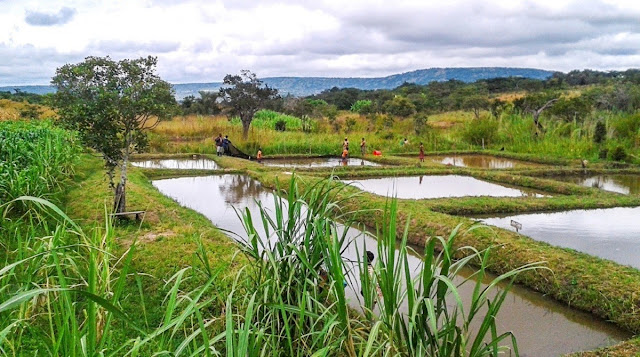Fish farming is the generalized and commonly used term for the
technique of aquaculture. In fish farming, the baby fishes are either produced
by artificial breeding of the fish brooders or collected from the natural
waters and then stocked in the man-made ponds. These are then grown on the
natural food in the pond supplemented by the other man-made feeds. After the fishes
grow to the marketable size say of ½ to one kilo or more, the fish is harvested
and sold in the market.
10
types of fish farming
1.
Fish hatchery
Hatchery is a kind of artificial fish breeding place, which carries
out reproduction, hatching and growth in various stages of the life cycle of
fish. Choosing the right fish is very important. Some common fish in hatcheries
are shrimp, Tilapia, Salmon, Scallops, Carp fish, etc.
2.
Tilapia fish farming
Tilapia farming is very profitable. Some of the main reasons tilapia
is profitable include its high protein content, rapid growth and large size compared
to other fish.
3.
Shrimp farming
Shrimp farming is another fish farming business that is considered
profitable. The demand for shrimp is so high that you can start small or large.
4.
Crab farming
Crab farming is another lucrative business. When running a crab
farming business, you can reduce land and labour costs, and you can produce
commercial quantities in a small area. Crabs grow very quickly and are highly
accepted and desired in the market. Pricing is also great.
5.
Prawn farming
Prawn farming is another fish farming business, where there is a lot
of profit, probably due to the high demand for prawn.
6.
Ornamental fish farming
Ornamental fish are loosely called ornamental fish. They are
beautiful, gorgeous and colourful. The demand for ornamental fish has increased
greatly and there is a good market for them.
7.
Cat fish farming
This is one of the most common fish farming operations. The cat-fish
business is so profitable that farmers can easily combine it with other fish.
In any case, startup costs are reasonable, depending on your location. You can
easily start small.
8.
Carp fish farming
This is another fish farming business where you can delve into and
capture the market. Carp are known as omnivorous fish, although they tend to
eat animal foods as molluscs, as well as worms and insect larvae. You may not
necessarily spend too much on feed when you are in the carp farming business.
9.
Salmon fish farming
Salmon is a fish that is considered a carnivore. You can also drill
down into salmon farming and start producing commercial quantities.
10.
Indoor fish farming
You can start an indoor fish business from your backyard, in a tank,
for very little money.
Benefits
of fish farming
1. The demand for
fish in the market is high and so fish can give you a better income.
2. Fish contains a
high amount of protein and other essential minerals, therefore, the price for
it is also high.
3. The central and
state government gives subsidy for fish farming which reduces the investment
cost for farming.
4. Fish farming
also acts as a side income source for farmers beside other farming/ cultivation.
5. The Maintenance
and care for fish farming is less, therefore, maintenance cost is low.
6. It is riskless
farming unlike other agriculture farming depend on the climatic condition and
seasons where it depends on the water source and maintenance practice.
7. For fish
farming, SBI and other banks provide a loan at a low rate.
8. Fish farming
recovers its farming cost faster in comparison with other farming.
9. In other crop
cultivation, the harvested crop has a chance of low market price if market
supply is high but in fish farming, the rate of fish is uniform throughout the
year.
10. Fish farming
has low investment and is highly profitable.
Questions about how lucrative fish farming really is?
Questions such as “What is the average fish farming profit margin”
How does it compare to shrimp farming profit margin? “How profitable is fish
farming?” “Is fish farming more lucrative than poultry?” “Do you make money in
fish farming” etc. tends to come from prospective individuals who are looking
at setting up a fish farming business.
Interestingly, these questions often lead to debates led by
unwitting users who may not even raise fish.
If
you enjoyed this post about fish farming and would love to see more, join us on
YouTube, Instagram, Facebook & X !











Comments
Post a Comment